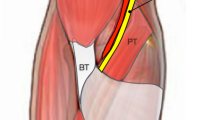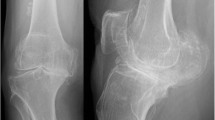Abstract
Purpose
The common peroneal nerve (CPN) can be injured during fibular-based posterolateral reconstructions due to its close relationship to the neck of the fibula. Therefore, the purpose of this study was to observe the course of the CPN and its branches around the fibular head and neck and quantify the position in relation to relevant bony landmarks and observe the relation between tunnel drilling for posterolateral corner reconstruction and both the tunnel entry and exit at the proximal fibula and the CPN and its branches was observed.
Methods
In 101 (mean age = 70.6 ± 16 years) embalmed cadaver knees, the relationship between bony landmarks (tibial tuberosity, styloid process of fibula (APR)) and the CPN and its branches were established and 8 (M1–M8) distances from these landmarks measured; mean, SD and 95% CI were recorded. In 21 of these knees, a fibula tunnel was drilled as in PLC reconstruction and the association of the CPN and its branches to the tunnel entry and exit were judged by two independent observers. Fisher’s exact test of independence was used to determine significant differences between genders. Tunnel intersection was analysed in a binary yes/no fashion and was described in frequencies and percentages.
Results
The mean distance from the APR to where the CPN reaches the fibula neck (M1) was 31.4 ± 8.9 mm (CI:29.8–33.0); from the apex of the styloid process (APR) to where the CPN passes posterior to the broadest point of the fibular head (M3) was 21.7 ± 12.6 mm (CI:19.4–24.0); from the apex of the APR to the most proximal point of the CPN/CPN first branch in the midline of the fibular head (M2) was 37.0 ± 6.7 mm (CI: 35.4–37.7). Out of the 21 randomly selected knees for drilling, the first branch of the CPN was damaged at the tunnel entry point in 7 (33%), and in 5 knees (24%), the CPN was damaged at the tunnel exit. In one knee, at both the tunnel entry and exit, the first branch of the CPN and the CPN were intersected, respectively.
Conclusion
The results of this study strongly suggest that the CPN is at risk when drilling the fibula tunnel performing fibula-based posterolateral corner reconstructions. The total injury rate was 57% with a 33% incidence of injury to the first branch of the nerve at the tunnel entry and 24% to the CPN at the tunnel exit.
Clinical Relevance
Due to the high incidence of injury, percutaneous placement of guide pins and tunnel drilling is not recommended. The nerve should be visualized and protected by either a traditional open approach or minimally invasive techniques. With a minimally invasive approach, the nerve should be identified at the fibula neck and then followed ante- and retrograde.







Similar content being viewed by others
References
Ridley TJ, McCarthy MA, Bollier MJ, Wolf BR, Amendola A (2018) The incidence and clinical outcomes of peroneal nerve injuries associated with posterolateral corner injuries of the knee. Knee Surg Sports Traumatol Arthrosc 26:806–811. https://doi.org/10.1007/s00167-016-4417-2
Geeslin AG, Moulton SG, LAPrade RF (2016) A systematic review of the outcomes of posterolateral corner injuries, Part 1: surgical treatment of acute injuries. Am J Sports Med 44(5):1336–1342. https://doi.org/10.1177/0363546515592828
Baker CL Jr, Norwood LA, Hughston JC (1983) Acute posterolateral rotatory instability of the knee. J Bone Joint Surg 65(5):614–618. https://doi.org/10.1177/036354658301100403
Baker CL Jr, Norwood LA, Hughston JC (1984) Acute combined posterior cruciate and posterolateral instability of the knee. Am J Sports Med 12(3):204–208. https://doi.org/10.1177/036354658401200307
Levy BA, Dajani KA, Morgan JA, Shah JP, Dahm DL, Stuart MJ (2010) Repair versus reconstruction of the fibular collateral ligament and posterolateral corner in the multiligament-injured knee. Am J Sports Med 38(4):804–809. https://doi.org/10.1177/0363546509352459
Woodmass J, Sanders TL, Johnson NR, Wu IT, Krych A, Stuart MJ, Levy BA (2018) Posterolateral corner reconstruction using the anatomical two-tailed graft technique: clinical outcomes in the multiligament injured knee. J Knee Surg; 31:1031–1036. [PMID 29444543]. https://doi.org/10.1055/s-0038-1632377
Fanelli GC, Fanelli DG (2015) Fibular head-based posterolateral reconstruction of the knee combined with capsular shift procedure. Sports Med Arthrosc Rev 23:33–43. https://doi.org/10.1097/JSA.0000000000000042
Zantop T, Petersen W (2010) Modified Larson technique for posterolateral corner reconstruction of the knee. Oper Orthop Traumatol 22(4):373–386. https://doi.org/10.1007/s00064-010-9030-9
Panzica M, Janzik J, Bobrowitsch E, Krettek C, Hawi N, Hurschler C, Jagodzinski M (2017) Biomechanical comparison of two surgical techniques of the posterolateral complex of the knee. Arch Orthop Trauma Surg 135:1579–1588. https://doi.org/10.1007/s00402-015-2319-2
Sullivan JP, McCarthy M, Marx R (2015) Outcomes for surgical treatment of posterolateral instability of the knee. Sports Med Arthrosc Rev 23:55–59. https://doi.org/10.1097/JSA.0000000000000037
Ishigooka H, Campbell ST, Quigley RJ, McGarry MH, Chen YJ, Gupta A, Bui CNH, Lee TQ (2016) Anatomic posterolateral corner reconstruction using a fibula cross-tunnel technique: a cadaveric biomechanical study. Arthroscopy 32(11):2300–2307. https://doi.org/10.1016/j.arthro.2016.03.017
Van der Wal WA, Heesterbeck PJC, van Tienen TG, Busch VJ, van Ochten JHM, Wymenga AB (2016) Anatomical reconstruction of the posterolateral corner and combined injuries of the knee. Knee Surg Sports Traumatol Arthrosc 24:221–228. https://doi.org/10.1007/s00167-014-3369-7
Helito CP, Sobrado MF, Giglio PN, Bonadio MB, Demange MK, Pecora JR, Camnho GL, Angelini FJ (2019) Posterolateral reconstruction combined with one-stage tibial valgus osteotomy: technical considerations and functional results. Knee 26:500–507. https://doi.org/10.1016/j.knee.2018.12.001
Yoon KH, Lee SH, Park SY, Park SE, Tak DH (2016) Comparison of anatomic posterolateral knee reconstruction using two different popliteofibular ligament techniques. Am J Sports Med 44(4):916–921. https://doi.org/10.1177/0363546515623966
Stannard JP, Brown SL, Robinson JT, McGwin G, Volgas DA (2005) Reconstruction of the posterolateral corner of the knee. Arthroscopy 21(9):1051–1059. https://doi.org/10.1016/j.arthro.2005.05.020
Niki Y, Matsumoto H, Otani T, Enomoto H, Toyama Y, Suda Y (2012) A modified Larson’s method of posterolateral corner reconstruction reproducing the physiological tensioning patterns of the lateral collateral and popliteofibular ligaments. Sports Med Arthrosc Rehabil Ther Technol 4(1):21. https://doi.org/10.1186/1758-2555-4-21
Weiss S, Krause M, Frosch KH (2020). Posterolateral corner of the knee: a systematic literature review of current concepts of arthroscopic reconstruction. Arch Orthop Trauma [online ahead of print]. https://doi.org/10.1007/s00402-020-03607-z.
Pulos N, Shin EH, Spinner RJ, Shin AY (2019) Management of iatrogenic nerve injuries. J Am Acad Orthop Surg 18:e838–e848. https://doi.org/10.5435/JAAOS-D-18-00510
MacDonald P, Vo A (2015) Complications of posterolateral corner injuries of the knee and how to avoid them. Sports Med Arthrosc Rev 23:51–54. https://doi.org/10.1097/JSA.0000000000000049
Ryan W, Mahony N, Delaney M, O’Brien M, Murray P (2003) Relationship of the common peroneal nerve and its branches to the head and neck of the fibula. Clin Anat 16(6):501–505. https://doi.org/10.1002/ca.10155
Deutsch A, Wyzkowski RJ, Victoroff BN (1999) Evaluation of the common peroneal nerve. Defining nerve-at-risk in arthroscopically assisted lateral meniscus repair. Am J Sports Med 27(1):10–15. https://doi.org/10.1177/03635465990270010201
Watt T, Hariharan AR, Brezezinski DW, Caird MS, Zeller JL (2014) Branching patterns and localization of the common fibular (peroneal) nerve: an anatomical basis for planning safe surgical procedures. Surg Rad Anat 36(8):821–828. https://doi.org/10.1007/s00276-013-1242-x
Milanese S, Gordon S, Buettner P, Flavell C, Ruston S, Coe D, O’Sullivan W, McCormack S (2014) Reliability and concurrent validity of knee angle measurements: smart phone app versus universal goniometer used by experienced and novice clinicians. Man Ther 19(6):569–574. https://doi.org/10.1016/j.math.2014.05.009
Landis JR, Koch GG (1977) The measurement of observer agreement for categorical data. Biometrics 33(1):159–174
Van Rijnsoever FJ (2017) (I can’t get no)saturation: A simulation and guidelines for sample sizes in qualitative research. PLoS ONE 12(7):e0181689. https://doi.org/10.1371/journal.pone.0181689
Wechter JF, Bohm KC, Macalena JA, Sikka RS, Tompkins M (2015) Part II: the 500/600 fibular tunnel trajectory for posterolateral corner reconstruction in a cadaver model. Knee Surg Sports Traumatol Arthrosc 23:1895–1899. https://doi.org/10.1007/s00167-014-3087-1
Hermanowicz K, Malinowski K, Goralczyk A, Gusczyn T, LaPrade RF (2019) Minimally invasive, arthroscopic assisted anatomic posterolateral corner reconstruction. Arthrosc Techn 8(3):e251–e257. https://doi.org/10.1016/j.eats.2018.10.021
Shon OJ, Park JW, Kim BJ (2017) Current concepts of posterolateral corner injuries of the knee. Knee Surg Relat Res 29:256–268. https://doi.org/10.5792/ksrr.16.029
Song GY, Zhang H, Zhang J, Li Y, Feng H (2015) Anatomical popliteofibular ligament reconstruction of the knee joints: an all-arthroscopic technique. Knee Surg Sports Traumatol Arthrosc 23(10):2925–2929. https://doi.org/10.1007/s00167-015-3531-x
Krivic A, Stanec S, Zic R, Budi S, Milanovic R, Stanec Z (2003) Lesion of the peroneal nerve during arthroscopy. Arthroscopy 19(9):1015–1018. https://doi.org/10.1016/j.arthro.2003.09.011
Vega-Espana EA, Vilchis-Samano H, Ruiz-Mejia O (2017) Minimally invasive reconstruction of the posterolateral corner with simultaneous replacement of the anterior cruciate ligament complex knee ligament injuries. Acta Ortop Mex 31(6):279–282
Johnson ME, Foster L, DeLee JC (2008) Neurologic and vascular injuries associated with knee ligament injuries. Am J Sports Med 36(12):2448–2462. https://doi.org/10.1177/0363546508325669
Eisma R, Lamb C, Soames RW (2013) From formalin to Thiel embalming: What changes? One anatomy department’s experiences. Clin Anat 26(5):564–571. https://doi.org/10.1002/ca.22222
Kennel L, Martin DMA, Shaw H, Wilkinson T (2018) Learning anatomy through Thiel- versus formalin-embalmed cadavers: student perceptions of embalming methods and effects on functional anatomy knowledge. Anat Sci Educ 11(2):166–174. https://doi.org/10.1002/ase.1715
Author information
Authors and Affiliations
Corresponding author
Ethics declarations
Conflict of interest
The authors declare no conflict of interest with the presented body of research.
Ethical approval
This project was approved by the University of Pretoria Institutional Review Board and Human Research Ethics Committee.
Additional information
Publisher's Note
Springer Nature remains neutral with regard to jurisdictional claims in published maps and institutional affiliations.
Rights and permissions
About this article
Cite this article
Hohmann, E., Van Zyl, R., Glatt, V. et al. The anatomical relationship of the common peroneal nerve to the proximal fibula and its clinical significance when performing fibular-based posterolateral reconstructions. Arch Orthop Trauma Surg 141, 437–445 (2021). https://doi.org/10.1007/s00402-020-03708-9
Received:
Accepted:
Published:
Issue Date:
DOI: https://doi.org/10.1007/s00402-020-03708-9




